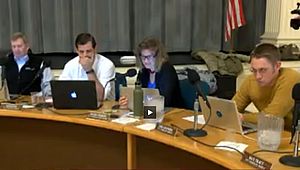Act Locally For Water Quality

Water quality protection starts in your own town. Image from CCTV.
The phrase “think globally, act locally” has been a mantra of the environmental movement for at least 45 years. It urges people to consider the health of the entire planet when making decisions or taking actions close to home. While Lake Champlain isn’t the globe, the phrase applies to our watershed. So many of the actions that need to be taken to manage the lake need to occur at a local level, and responsibilities for those actions fall on local governments.
The idea was summarized in a recent opinion piece about the Chesapeake Bay. “While the federal government and state agencies go about setting goals and establishing priorities, in the end it is local governments that implement many of the pollution controls measures,” wrote Nick DiPasquale, director of the Chesapeake Bay Program. Some of those local decisions involve planning and zoning, permitting, stormwater management, road maintenance, and water quality infrastructure.
Water quality protection starts with local planning and zoning. At this stage, communities can identify important resources worth protecting and act accordingly. Zoning can help direct development to central areas and avoid scattered projects sprawling out across the landscape. Clustered development protects the land’s ability to filter rain water and treat pollutants.
Local communities are also responsible for carrying out many of the permits issued by state governments. Burlington is piloting a program to allow comprehensive permitting. Under this program, rather than having separate permits for drinking water, waste water, combined sewer overflows, and stormwater management, the City will have one comprehensive permit addressing all water issues. This will allow the City to prioritize resources and projects between the different elements of water quality protection, and budget resources to address the greatest needs first.
Much of the responsibility for stormwater management and control comes under the auspices of local communities. Vermont has proposed municipality-wide stormwater runoff control plans for communities discharging a significant amount of untreated stormwater. Larger communities are already required to have such plans. Stormwater can also be managed through the promotion of green stormwater infrastructure that mimics natural processes to capture, reuse or filter stormwater. Examples include rain gardens, urban trees, and other infiltration practices. Municipalities can promote green infrastructure in their planning and approach to public works.
Local road management presents a significant challenge for local communities. Municipalities can conduct local road inventories that identify areas of erosion and stormwater discharge and develop a plan for addressing these issues. In addition to protecting water quality, such proactive actions save the taxpayers in the long run.
Undersized culverts on local roads are a particular problem. Undersized culverts cause and ditches to back up and increase erosion. They are vulnerable to blow outs during rain events, and can prevent fish and other aquatic organisms from moving upstream. Though replacing culverts is expensive, municipal road plans should identify undersized culverts and develop a plan for replacing them over time.
Local control of drinking and waste water utilities is perhaps the area where local communities have the most responsibility. A report by the U.S. Council of Mayors noted, “Like many other forms of public infrastructure in America, water and wastewater suffer from the lack of a coordinated and integrated National Strategy. Rather than provide leadership, Congress and the federal government have essentially abandoned providing meaningful financial assistance to local government, but have, instead, authorized and implemented a costly and increasing wave of mandates. The mandates lack prioritization based on comparative risk; and are not coordinated to match compliance phase-in with the ability of local governments to finance improvements.”
Without federal investment in water infrastructure there are significant discrepancies between rich and poor communities. Wealthy communities with a substantial tax base are able to keep on top of their infrastructure upgrade needs, while poor communities lack the capacity to pay for routine maintenance.
While actions at the state and level draw more attention, much of the work to be done to protect water quality happens in your own back yard with local decisions. Just a few strong voices advocating for a progressive approach to managing water can have a strong influence at the local level. Political participation begins at the ballot box, but it shouldn’t end there. Opportunities to shape your local environment include serving on local planning commissions, select boards, or development review boards. The outcomes aren’t as glamorous as perhaps passing a state law but they are critical to enacting broader policies. Think globally and act locally.
